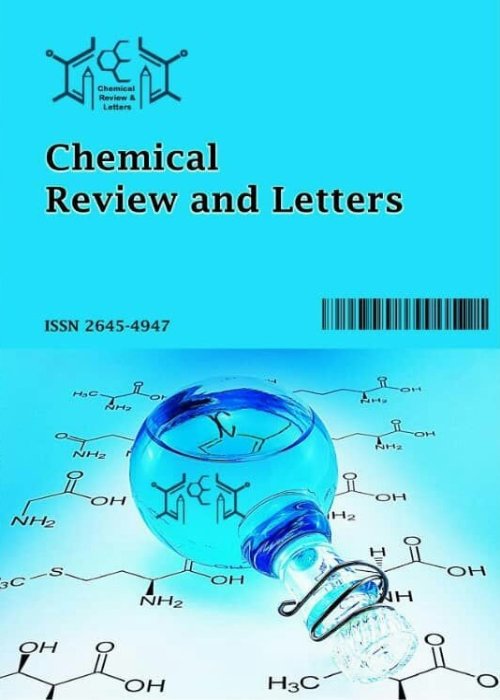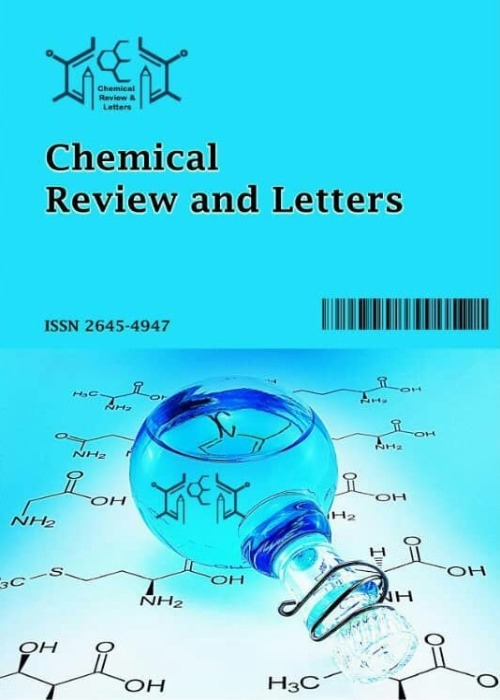فهرست مطالب

Chemical Review and Letters
Volume:6 Issue: 4, Autumn 2023
- تاریخ انتشار: 1402/09/10
- تعداد عناوین: 10
-
-
Pages 403-414
Direct C-H functionalization of unactivated (hetero)arenes with organohalides or sulfonates has proven to be an effective strategy for the formation of new C(aryl)-C(aryl/alkyl) bonds. However, organo(pseudo)halides are mainly highly toxic, which is unfavourable for large-scale and sustainable use. As an alternative to this method, deformylative C-H functionalization of (hetero)arenes with aldehydes has been suggested to be effective because it could further enrich the synthetic methodology due to low-cost, nontoxicity, and easy accessibility of aldehydes. In this review, we focus on the recent advances in this promising and hot research topic which may inspire further research in this domain.
Keywords: C-H functionalization, deformylative cross-coupling, C-C bonds, Aldehydes, biaryls -
Pages 415-427This study employs Density Functional Theory (DFT) methodology to comprehensively investigate the structural and physicochemical characteristics of epinephrine, a molecule of physiological relevance. By employing DFT approaches, a more precise description of epinephrine's structure and properties is achieved compared to prior studies. A detailed examination of epinephrine's structure and various properties, such as the Highest Occupied Molecular Orbital (HOMO), Lowest Unoccupied Molecular Orbital (LUMO), Band Gap (BG), Density of States (DOS), Fourier-Transform Infrared Spectroscopy (FT-IR), Ultraviolet (UV) absorption, and Natural Bond Orbital (NBO) analysis. Furthermore, we explore non-covalent interactions (NCI) through the examination of Reduced Density Gradient (RDG) and Molecular Electrostatic Potential (MEP) maps. Incorporating FT-IR results, we delve into the vibrational properties of epinephrine, highlighting C-H vibrations at 3700, 3176.20, and 2986.14 cm-1, along with specific vibrational modes of the benzene ring at 1558.43 and 1461.14 cm-1. Additionally, we provide a comprehensive analysis of epinephrine's thermochemical properties at temperatures ranging from 100 to 200 K under constant pressure conditions (1 atm), including optical transitions. This comprehensive investigation enhances our understanding of epinephrine's structure and properties, paving the way for a more profound comprehension of its biological and pharmacological significance.Keywords: Epinephrine, Physicochemical, Thermochemistry, Optical properties, NCI, RDG
-
Pages 428-441
In man-made structures, corrosion is one of the most important problems and environmentally friendly protective coatings are one of the vital requests in different industries. In this article, silane-based sol-gel coatings, as a substitution to toxic coatings based on chromates, have been evaluated. The role of using different green additives, extracted from plants, to deal with corrosion in different corrosive media has been investigated. However, different parameters can affect the efficiency of these materials such as pH, temperature, concentration, substrate type, media, compatibility, etc. The comparison of the anti-corrosion performance of silane sol gel coatings containing these green inhibitors showed that there is much potential for the broader application of these safe materials for maintenance of structures.
Keywords: Metallic Substrate, Corrosion Mitigation, Sol-Gel, Protective coating, Green Inhibitors -
Pages 442-448Uracil derivatives have been the focus of many researchers examining their potential as a cancer-fighting agent. Human breast, liver, and lung cancer cells were used to test the target compounds and compared to cisplatin. There was a wide range of activity in the newly synthesized compounds against breast and lung cancer, but none were effective against liver cancer. Nevertheless, the most effective substances were 4d and 4j, which were quite effective against both kinds of cell lines. It was shown that the 4d compound is more effective against breast cancer than 4a, 4b, and 4c compounds, and 4j showed higher cytotoxic activity than 4e, 4f, and g compounds. We have been told that further research into the toxicity of these potent substances, as well as in-vivo testing, are necessary.Keywords: Lung cancer, Azo Dyes, uracil, Azo, IC50, and cell line
-
Pages 449-460Since the presence of cadmium ions in the zinc production process causes many problems, removing this impurity is necessary at the cold purification stage. This study considers cadmium removal in the cold purification process of the Dandi zinc smelting plant (Zanjan-Iran). To this end, the cadmium cementation was conducted by using zinc dust in the leached solution of the Dandi zinc smelting plant and the synthetic solution. Furthermore, modeling of the system is performed to predict the behavior of cadmium removal. Therefore, cadmium cementation kinetic was studied at different temperatures, and the reaction rate constants were obtained. Then, the governing differential equation of cadmium removal was solved analytically. Finally, verify the model, the outcomes obtained from modeling were compared with the experimental data. Results showed that the mathematical modeling outcomes agree with the experimental data.Keywords: Cadmium cementation, Cold purification, Modeling, Reaction Kinetic, Zinc dust
-
Pages 461-478
The invention relates to an actuator for graphene oxide humidity response, and graphene has become a growing material in developing electronic devices due to its unique physical and chemical properties. For intelligent materials used in soft actuators, fast response and strong mechanical properties are required. The invention relates to the field of 4D printing of intelligent materials. Specifically, it relates to a field in which a shape-memory micro-nano composite material can be applied to 4D printing technology. The purpose of the invention is to solve the technical problem that 4D printing of shape-memory micro-nano composite materials is difficult to achieve. 4D printing technology has played an essential role in promoting the development of graphene materials as devices. This article reviews the research progress on the 4D printing of graphene in sensors and actuators. Using responsive nanocomposite and programming the same stimuli is also a creative way to look into making new soft actuators. It goes into more detail about the progress made in research on 4D printing graphene materials for sensors and actuators. Finally, it sums up how these materials will continue to grow and be used in the future.
Keywords: 4D Printing, intelligent materials, graphene, Actuators, applications -
Pages 479-493The effects of X-H⋯C and X–H⋯π interactions are considered where the hydrogen acids act as a proton donor and the different π-systems such as para-substituted (H, F, Cl, OH, SH, CH3, and NH2) benzene derivatives act as a proton acceptor. The influence of substituents on the strength of interactions indicates that the electron-withdrawing groups weaken the interaction while electron-donating ones strengthen it. Topological properties of charge density show low ρ and positive 2ρBCP values and these properties are typical for closed-shell interactions. Based on the obtained natural bond orbital analysis results, the greatest charge transfer occurs in the HF complexes, while the smallest of that belongs to the HBr ones. The aromaticity indicators are also examined upon complexation. Finally, the NMR data results exhibit that the maximum and minimum isotropic value of the proton shielding tensor corresponds to the HBr and HF complexes, respectively.Keywords: DFT, aim, NBO, NMR, Aromaticity indices
-
Pages 494-505
Sumanene (C21H12) is the smallest bowl-shaped molecule containing a central benzene ring, which is alternately surrounded by another 3 benzene rings and cyclopentadiene rings. In this study, the effect of various electron donor and receptor substitutions on its structure, electrical and optical properties were investigated. The results showed that the electron-bonding and electron-donor-acceptor groups to sumanene greatly affected the electrical properties. In contrast, the most significant effect occurred when NO and CH2Li substitutions were at the two positions simultaneously. These substitutions also greatly influenced optical properties and significantly increased its polarization and polarization values. The most significant effect occurred when BH2 and NCH3Li were replaced in position 1. Finally, the absorption spectrum of the substituted molecules was examined when the BH2-NCH3Li groups were in position 1.
Keywords: Sumanene, Orbital Energy, Absorption spectra, Optical properties -
Pages 506-512
The protonation constants values of mercaptosuccinic acid were determined in ethylene glycol and water media (0-60% v/v) at 303.0 K at ionic strength of 0.16 M using pH metric technique. The protonation constants were calculated with the computer program MINIQUAD 75 and selection of the best fit chemical models were arrived based on the statistical parameters. the log K values were found to increase with increase of the organic solvent content. The linear variations of the protonation constants with the reciprocal of the dielectric constant of the medium have been attributed to the dominance of electrostatic forces. Distribution of species, protonation equilibria and effect of influential parameters on the protonation constants has also been reported.
Keywords: Mercapto succinic acid, MINIQUAD75, Protonation constant, Dielectric Constant -
Pages 513-521The Sol-Gel method synthesizes ZnO@TiO2 thin film structures on Si/SiO2 substrates, particularly enhancing photocurrent response and photovoltaic characteristics. Using the Sol-Gel method, the study aims to provide insights into the features and implications of the photocurrent response under visible light illumination. Examining various parameters such as current amplitude, resistivity, rise time, fall time, rise time to fall time ratio, and photocurrent amplitude to rise time/fall time ratio, this research seeks to understand the performance of the synthesized thin film structures. Among the studied delicate film structures, the hybrid ZnO: TiO2 exhibits the highest current responsiveness, while TiO2 and TiO2/ZnO demonstrate dark everyday phenomena. These findings hold significance for optimizing the design of photovoltaic devices utilizing the Sol-Gel method. By investigating ZnO@TiO2 thin film structures on Si/SiO2 substrates using the Sol-Gel method, this research provides valuable insights into these structures' performance and potential applications in photovoltaics. The results contribute to advancing renewable energy technologies and guide the development of efficient photovoltaic devices.Keywords: Sol-gel method, Photocurrent response, ZnO, TiO2, Time-dependent variables, Si, SiO2 substrate


